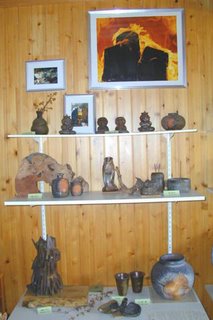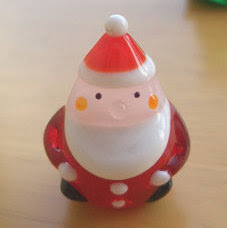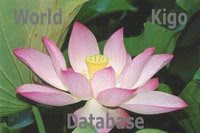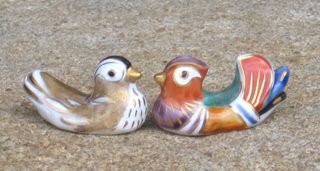:::::::::::::::::::::::::::::::::::::::::::::::::::::::::::::::::::::::::::::::::::::::::::::::::::::
Byoobu and Tsuitate -
Daruma on a Screen
屏風、衝立とだるま

. Byobu 屏風 (びょうぶ byoobu)
Folding Screen Exhibitions
:::::::::::::::::::::::::::::::::::::::::::::::::::::::::::::::::::::::::::::::::::::::::::::::::::::

. Kaneda Sekijo 金田石城 .
高崎で書道家・金田石城さんの作品展
December 11, 2011 - Exhibition at Takasaki
:::::::::::::::::::::::::::::::::::::::::::::::::::::::::::::::::::::::::::::::::::::::::::::::::::::
The context of Japanese interior was already covered in the story about sliding doors, Fusuma, so please refer to this before reading on.
. Fusuma - Daruma on a Sliding Door
襖絵とだるま
The golden age for folding screens and paravents was the Momoyama and Muromachi period. Together with the sliding door paintings they were the best medium to lavishly decorate a room and also to give expression to the painters individual taste. A folding screen set usually consists of two screens with six panels each and thus provided a large canvas, sometimes covered completely with gold foil. Chinese (too-e 唐絵) and Japanese motives (yamato-e 大和絵) where the two mainstreams of this extremely rich genre.
The word BYOOBU (byobu) originally means "Protection from the wind", so they were used to ward off drafts, but generally they were movabel walls used to partition a room for ceremonial or other occasions. The first screens were introduced from China and Korea, but soon became a thouroughly Japanese part of the interior and sometimes they were even used as presents by the Japanese envoys to the Chinese court.
The earliest screens were painted on separate panels and then hinged with leather or cloth pulled through holes at the edge of the wooden frames.
The oldest screens in Japan are kept in the imperial treasurehouse Shoosooin (Shosoin 正倉院) on the grounds of the temple Todai-ji in Nara and date from around 750 A.D. They consist of paintings on paper and silk and panels of woven fabric. While almost all early Japanese art was centered around Buddhism, the subject matter of the screens is uniquely secular and includes palast scenes, landscapes, poetry, natural themes such as animals, birds, flowers and grass or human figures.
A new Korean technique introduced in the mid-fourteenth century hinged the screen panels together with paper and offered more continuous surface on which to paint. This opportunity for new formats and changes in composition eventually brought the art of Japanes screen paintings to its zenith.
The introduction of firearms to Japan by the Portugese in the mid sixteenth century revolutionized warfare and with it, architecture, ushering in a golden age of screen painting during the Momoyama period. The monumental (and drafty) castles made necessary by the use of guns, where perfect for large, lavishly decorated screens. The liberal use of gold backgrounds not only symbolized the strenght and wealth of the new warlords but, more practically, served to reflect light and illuminate the vast, gloomy interiors.
Folding Screen, Facts by JAANUS
.................................................................................
tsukinami byoobu e 月並み屏風絵
tsukinami byoobu 月並屏風
Byobu with paintings of the 12 months
each with a special seasonal aspect, coming usually from waka poetry.

source : www.artelista.com
Tsukinami fuzokuzu senmen nagashi byobu
Genre scenes of the twelve months
by Kano Motonobu
. Byobu - Online Reference
:::::::::::::::::::::::::::::::::::::::::::::::::::::::::::::::::::::::::::::::::::::::::::::::::::::

One of my favorite classical screens is the one depicting the
Gods of Wind and Thunder (fuujin raijinzu byoobu 風神雷神図屏風)
by Tawaraya Sotatsu (?-1640) from the famous old Zen temple Kennin-ji.
建仁寺の風神雷神図屏風
Tawaraya Sootatsu 俵屋宗達
.................................................................................

Famous screen about traditional dancers by
Tawaraya Sotatsu
俵屋宗達作の舞楽図屏風
.................................................................................
Ogata Koorin 尾形光琳 Ogata Korin

White and Red Plums 紅白梅図屏風

Autumn Grass 秋草図屏風
:::::::::::::::::::::::::::::::::::::::::::::::::::::::::::::::::::::::::::::::::::::::::::::::::::::
Another wild example is the amazing screen by
Soga Shohaku (1730 -81),
depicting some hermits, but with bold strokes and in vivid colors, in contrast to the hermits we will meet a little later.
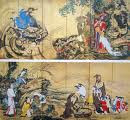
Soga Shoohaku 曾我蕭白作「群仙図屏風」
. Soga Shohaku 曽我蕭白1730–1781
.................................................................................
The famous screens by Ishida Yutei (Ishida Yuutei (1721-1786), featuring a group of herons on a golden background.

石田幽汀の群鶴図
.................................................................................

A special genre are the folding screens with decorations of fans, called
Senmen Harimaze Byoobu (扇面貼交屏風).
:::::::::::::::::::::::::::::::::::::::::::::::::::::::::::::::::::::::::::::::::::::::::::::::::::::
Folding screens for a wedding ceremony
Golden screens are quite popular these days.
屏風 結婚式
. . . CLICK here for Photos !
:::::::::::::::::::::::::::::::::::::::::::::::::::::::::::::::::::::::::::::::::::::::::::::::::::::
The following folding screen brings us back to the subject of Zen.
The "Eight Drinking Hermits"
by Kaiho Yusho (Kaihoo Yuushoo 1533-1615) are close to the Zen way of life.

飲中八仙図も禅の世界に近い屏風
海北友松(1533-1615)
.................................................................................
. Tokyo National Museum - Byobu Collection
屏風 - 京都国立博物館
. Byobu from the Momoyama Period
屏風 桃山絵画賛歌
:::::::::::::::::::::::::::::::::::::::::::::::::::::::::::::::::::::::::::::::::::::::::::::::::::::
Daruma on a Folding Screen

source : seigetu23
.................................................................................

Onna Daruma - Daruma as a woman
source : tonton3
:::::::::::::::::::::::::::::::::::::::::::::::::::::::::::::::::::::::::::::::::::::::::::::::::::::
Fotos TBA
During a trip to Nishi-Izu in 1991 I found a small temple, Hongan-ji near Dogashima, with a somehow homemade screen wiht a picture of Daruma san. It shows Daruma below the inscription "Every Day is a Good Day", which we already saw in the story about Fusuma.
“日々是好日”
西伊豆の堂ヶ島の近くにある本願寺
In the entrance of the Daruma temple Hoorin-ji in Kyoto I found these two items, a folding screen with two panels and simple screen. The big Daruma face has a real hooked nose like an Indian monk.
京都の法輪寺にこの屏風と衝立をみつけました。
:::::::::::::::::::::::::::::::::::::::::::::::::::::::::::::::::::::::::::::::::::::::::::::::::::::
. Kigo for Winter .
portable screens, byoobu 屏風
used to keep the cold wind from reaching the body
gin byoobu, ginbyoobu 銀屏風(ぎんびょうぶ)silver folding screen

みじか夜や枕にちかき銀屏風
mijikayo ya makuramoto ni chikaki gin byoobu
short night -
near my pillow
a silver folding screen
. Yosa Buson 与謝蕪村 .
:::::::::::::::::::::::::::::::::::::::::::::::::::::::::::::::::::::::::::::::::::::::::::::::::::::::

kin byoobu, kinbyoobu 金屏風(きんびょうぶ)golden folding screen
..... kinbyoo 金屏(きんびょう)
金屏の松の古さよ冬籠り
kinbyoo no matsu no furusa yo fuyugomori
on the golden folding screen
the pine looks so old -
winter seclusion
Tr. Gabi Greve
Reclusione invernale:
sul paravento d'oro.
un pino scolorito.
Tr. Haiku del giorno
Matsuo Basho 松尾芭蕉, age 50
. . . . .
屏風には山を画書いて冬籠り
byoobu ni wa yama o egaite fuyu-gomori
on the folding screen
there is a painted mountain -
winter seclusion
Written in Genroku 2 元禄2年.
Greeting hokku for his disciple Hiranaka 平仲 in Iga, who had a splendid folding screen in his home. Basho later revised the poem to the GOLDEN SCREEN, above.
. Matsuo Basho 松尾芭蕉 - Archives of the WKD .
:::::::::::::::::::::::::::::::::::::::::::::::::::::::::::::::::::::::::::::::::::::::::::::::::::::::
金屏の羅は誰ガあきのかぜ
kinbyoo no usu mono wa taga aki no kaze
. Yosa Buson 与謝蕪村 .
in 安永五年七月二十日, 1777, on the 20th day of the 7th lunar month
maybe as a honkadori allusion to Basho
over the golden screen
who has hung her thin robes?
autumn wind
Tr. Gabi Greve
Upon the golden screens
gauze clothes are painted-- whose?
The autumn winds
Tr. Henderson
Whose thin clothes
still decorate the gold screen?
Autumn wind.
Tr. Dave Bonta
slung over a screen
a dress of silk and gauze;
autumn breeze
Tr. ?
usumono, ra 羅 thin robes, is a kigo for summer.
Golden screens were used as a formal decoration. In small format also for the Hina Doll decoration and other decorations.
On the same day Buson also wrote a haiku about fish dried on the beach in the autumn wind.
秋風や干魚かけたる浜庇
and another haiku about the golden screen
written 安永六年四月十三日 1777, on the 13th day of the fourth lunar month
金屏のかくやくとして牡丹哉
kinbyoo no kakuyaku to shite botan kana

:::::::::::::::::::::::::::::::::::::::::::::::::::::::::::::::::::::::::::::::::::::::::::::::::::::
:::::::::::::::::::::::::::::::::::::::::::::::::::::::::::::::::::::::::::::::::::::::::::::::::::::
Tsuitate 衝立 partitioning screen
This is a standing screen consisting of a single panel supported on two feet. It is used to seperate off a corner of a room or placed in front of an open doorway to gain a little privacy or block a direct breeze.
Sometimes it contains of a simple large piece of beautiful wood and stands in the entrance of a mansion or hotel to prevent the full view of the lobby.
.................................................................................

From Toyama Town
source : 富山の商店街
.................................................................................

at Temple Tenryu-Ji 天龍寺
source : junsplace.blog
.................................................................................

Daruma Memorial Day Celebration, Head Priest Ito San
at temple Gokuraku-Ji 極楽寺の達磨忌
Tokyo, Ayabe Town 京都府綾部市
source : ayabebunnkazai
.................................................................................

source : hiroshima-art.net
.................................................................................

Daruma, by 高木梅荘
source : chikurindou.co.jp
.................................................................................

source : narun, a painter
:::::::::::::::::::::::::::::::::::::::::::::::::::::::::::::::::::::::::::::::::::::::::::::::::::::
gachoo 画帳 - 画帖 painting collections
usually with paintings of plants, animals and poems of the 12 months
For example
kachoo waka 花鳥和歌各十二首
Twelve- Month Poem Series on Flowers and Birds
by Fujiwara no Teika 藤原定家

source : www.miho.or.jp
New Year : Bush Warbler on Willow Tree
According to his diary MEIGETSUKI 明月記:
1 first month, willow yanagi 柳 and warbler uguisu 鴬 ;
2 second month, cherry sakura 桜 and pheasant kiji 雉 ;
3 third month, wisteria (uji 藤 and skylark hibari 雲雀 ;
4 forth month, deutzia unohana 卯の花 and cuckoo hototogisu 時鳥 ;
5 fifth month, orange tachibana 橘 and water-rail kuina 水鶏 ;
6 sixth month, pinks nadeshiko 撫子 and cormorant u 鵜 ;
7 seventh month, maidenflower ominaehi 女郎花 and magpie kasasagi 鵲 ;
8 eighth month, bush-clover hagi 萩 and wild goose hatsukari 初雁 ;
9 ninth month, miscanthus susuki 薄 and quail uzura 鶉 ;
10 tenth month, chrysanthemum kiku 菊 and cranes tsuru 鶴 ;
11 eleventh month, loquat biwa 枇杷 and plovers chidori 千鳥 ; and
12 twelfth month, early plum soubai 早梅 and mandarin ducks mizutori 水鳥.
source : JAANUS
:::::::::::::::::::::::::::::::::::::::::::::::::::::::::::::::::::::::::::::::::::::::::::::::::::::
. kai byoobu 貝屏風 folding screen with sea shells .
[ . BACK to DARUMA MUSEUM TOP . ]
[ . BACK to WORLDKIGO . TOP . ]
:::::::::::::::::::::::::::::::::::::::::::::::::::::::::::::::::::::::::::::::::::::::::::::::::::::

